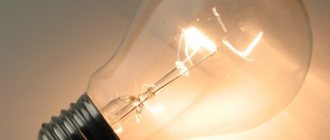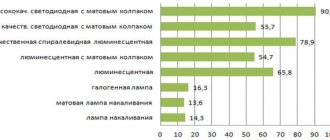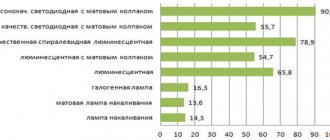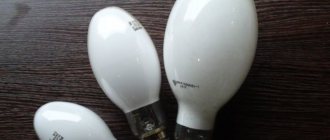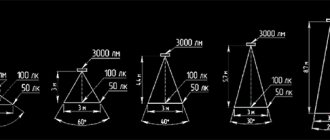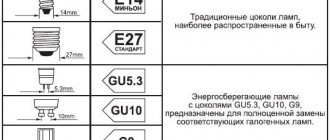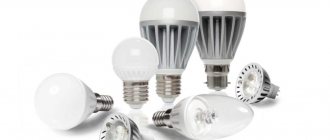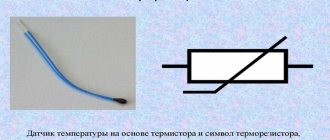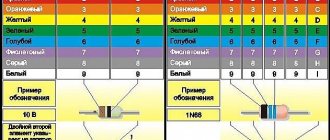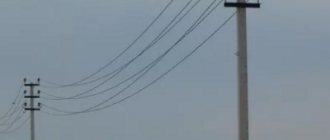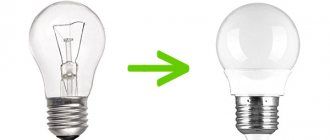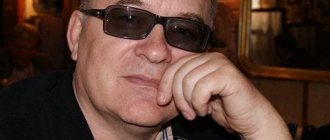The incandescent lamp is the first electric lighting device that plays an important role in human life. It is this that allows people to go about their business regardless of the time of day.
Compared to other light sources, this device is characterized by simplicity of design. The luminous flux is emitted by a tungsten filament located inside a glass bulb, the cavity of which is filled with a deep vacuum. Later, to increase durability, instead of vacuum, special gases began to be pumped into the flask - this is how halogen lamps appeared. Tungsten is a heat-resistant material with a high melting point. This is very important, because in order for a person to see the glow, the thread must become very hot due to the current passing through it.
History of creation
Interestingly, the first lamps did not use tungsten, but a number of other materials, including paper, graphite and bamboo. Therefore, despite the fact that all the laurels for the invention and improvement of the incandescent lamp belong to Edison and Lodygin, it is wrong to attribute all the merits only to them.
We will not write about the failures of individual scientists, but we will give the main directions in which the efforts of the men of that time were made:
- The search for the best filament material. It was necessary to find a material that was both resistant to fire and characterized by high resistance. The first thread was created from bamboo fibers, which were covered with a thin layer of graphite. Bamboo acted as an insulator, graphite as a conductive medium. Since the layer was small, the resistance increased significantly (as required). Everything would be fine, but the wood base of the coal led to rapid ignition.
- Next, the researchers thought about how to create conditions of the strictest vacuum, because oxygen is an important element for the combustion process.
- After this, it was necessary to create the connector and contact components of the electrical circuit. The task was complicated by the use of a layer of graphite, which is characterized by high resistance, so the scientists had to use precious metals - platinum and silver. This increased the current conductivity, but the cost of the product was too high.
- It is noteworthy that the Edison base thread is still used to this day - marked E27. The first methods of creating a contact involved soldering, but in this situation today it would be difficult to talk about quickly replaceable light bulbs. And with strong heating, such compounds would quickly disintegrate.
Nowadays, the popularity of such lamps is falling exponentially. In 2003, in Russia the amplitude of the supply voltage was increased by 5%; today this parameter is already 10%. This led to a reduction in the life of the incandescent lamp by 4 times. On the other hand, if you return the voltage to an equivalent value down, the luminous flux output will be significantly reduced - up to 40%.
Remember the training course - back in school, a physics teacher conducted experiments demonstrating how the glow of a lamp increases with increasing current supplied to the tungsten filament. The higher the current, the stronger the emission of radiation and the more heat.
Edison decorative lamps
The Edison lamp in the interior not only performs its direct function, but also helps create interiors in loft, minimalism, steampunk, Bauhaus, and contemporary styles. It resembles the design that was presented by the American inventor, but has acquired new features:
- The glass flask has various shapes and sizes.
Variety of shapes and sizes Source ae01.alicdn.com
- The number of tungsten filaments in it can reach 20. This is done for brightness of lighting and impressive appearance.
In addition to tungsten, a sapphire spiral is used, which gives a brighter light at the same energy costs Source vn.20minut.ua
- Another spiral option is LED. Its uniqueness is that the emitted light can be of both warm and cold spectrum. Besides
- The luminous threads inside the bulb are arranged in intricate ways, creating various shapes.
See also: Catalog of companies that specialize in electrical and lighting.
Operating principle
The principle of operation of the lamp is based on the strong heating of the filament due to the electric current passing through it. In order for a solid material to begin to emit a red glow, its temperature must reach 570 degrees. Celsius. The radiation will be pleasant to the human eye only if this parameter is increased by 3–4 times.
Few materials are characterized by such refractoriness. Due to the affordable pricing policy, the choice was made in favor of tungsten, whose melting point is 3400 degrees. Celsius. To increase the area of light emission, the tungsten filament is twisted into a spiral. During operation, it can heat up to 2800 degrees. Celsius. The color temperature of such radiation is 2000–3000 K, which gives a yellowish spectrum - incomparable with daylight, but at the same time does not have a negative effect on the visual organs.
Once in the air, tungsten quickly oxidizes and breaks down. As mentioned above, instead of a vacuum, a glass flask can be filled with gases. We are talking about inert nitrogen, argon or krypton. This allowed not only to increase durability, but also to increase the glow strength. The service life is affected by the fact that gas pressure prevents the evaporation of the tungsten filament due to the high glow temperature.
Principle of operation
An incandescent light bulb works by heating a substance while current flows through it. Electricity passes through a refractory conductor, heating it. The heating temperature depends on the voltage supplied to the light bulb. According to Planck's law, a heated radiating conductor can create electromagnetic radiation. The higher the temperature, the shorter the wavelength. Visible radiation, which the human eye can detect, appears when the conductor is heated to several thousand degrees. If the device is heated to 5000 K (Kelvin), neutral light appears; as the temperature decreases, radiation from yellow to red predominates in the spectrum.
Structure
A typical lamp consists of the following structural elements:
- flask;
- vacuum or inert gas pumped inside it;
- filament;
- electrodes - current terminals;
- hooks needed to hold the filament;
- leg;
- fuse;
- base, consisting of a housing, an insulator and a contact on the bottom.
In addition to standard versions made of conductor, glass vessel and leads, there are lamps for special purposes. Instead of a base, they use other holders or add an additional bulb.
The fuse is usually made of an alloy of ferrite and nickel and is placed in the gap on one of the current terminals. Often it is located in the leg. Its main purpose is to protect the flask from destruction in the event of a thread break. This is due to the fact that if it breaks, an electric arc is formed, leading to the melting of the remnants of the conductor, which fall on the glass bulb. Due to the high temperature, it may explode and cause a fire. However, for many years the low efficiency of fuses has been proven, so they are used less frequently.
Flask
The glass vessel is used to protect the filament from oxidation and destruction. The overall dimensions of the flask are selected depending on the deposition rate of the material from which the conductor is made.
Gas environment
If previously all incandescent lamps without exception were filled with vacuum, today this approach is used only for low-power light sources. More powerful devices are filled with inert gas. The molar mass of the gas affects the heat emitted by the filament.
Halogens are pumped into the bulb of halogen lamps. The substance with which the filament is coated begins to evaporate and interact with the halogens located inside the vessel. As a result of the reaction, compounds are formed that decompose again and the substance returns to the surface of the thread. Thanks to this, it became possible to increase the temperature of the conductor, increasing the efficiency and service life of the product. This approach also made it possible to make the flasks more compact. The design flaw is associated with the initially low resistance of the conductor when applying electric current.
Filament
The shape of the filament can be different - the choice in favor of one or the other depends on the specifics of the light bulb. They often use a thread with a round cross-section, twisted into a spiral, and much less often - ribbon conductors.
A modern incandescent lamp is powered by a filament made of tungsten or an osmium-tungsten alloy. Instead of conventional helices, bi-helices and tri-helices can be twisted, which is made possible by repeated twisting. The latter leads to a decrease in thermal radiation and an increase in efficiency.
Materials used in incandescent lamps
Metals
The main element of incandescent lamps is the filament body. To make a filament body, it is most advisable to use metals and other materials with electronic conductivity. In this case, by passing an electric current, the body will heat up to the required temperature. The material of the filament body must satisfy a number of requirements: have a high melting point, plasticity that allows drawing wire of various diameters, including very small ones, a low evaporation rate at operating temperatures, which ensures a long service life, and the like. Table 1 shows the melting temperatures of refractory metals. The most refractory metal is tungsten, which, along with high ductility and low evaporation rate, has ensured its widespread use as the filament of incandescent lamps.
Table 1
Melting point of metals and their compounds
| Metals | T, °С | Carbides and their mixtures | T, °С | Nitrides | T, °С | Borides | T, °С |
| Tungsten Rhenium Tantalum Osmium Molybdenum Niobium Iridium Zirconium Platinum | 3410 3180 3014 3050 2620 2470 2410 1825 1769 | 4TaC + + HiC 4TaC + + ZrC HfC TaC ZrC NbC TiC WC W2C MoC VnC ScC SiC | 3927 3927 3887 3877 3527 3427 3127 2867 2857 2687 2557 2377 2267 | TaC + + TaN HfN TiC + + TiN TaN ZrN TiN BN | 3373 3307 3227 3087 2977 2927 2727 | HfB ZrB WB | 3067 2987 2927 |
The evaporation rate of tungsten at temperatures of 2870 and 3270°C is 8.41×10-10 and 9.95×10-8 kg/(cm²×s).
Among other materials, rhenium can be considered promising, the melting point of which is slightly lower than that of tungsten. Rhenium can be easily machined when heated, is resistant to oxidation, and has a lower evaporation rate than tungsten. There are foreign publications on the production of lamps with tungsten filament with rhenium additives, as well as coating the filament with a layer of rhenium. Of the non-metallic compounds, tantalum carbide is of interest, the evaporation rate of which is 20–30% lower than that of tungsten. An obstacle to the use of carbides, in particular tantalum carbide, is their fragility.
Table 2 shows the main physical properties of an ideal filament body made of tungsten.
table 2
Basic physical properties of tungsten filament
| Temperature, K | Evaporation rate, kg/(m²×s) | Electrical resistivity, 10-6 Ohm×cm | Brightness cd/m² | Luminous efficacy, lm/W | Color temperature, K |
| 1000 1400 1800 2200 2600 3000 3400 | 5,32 × 10-35 2,51 × 10-23 8,81 × 10-17 1,24 × 10-12 8,41 × 10-10 9,95 × 10-8 3,47 × 10-6 | 24,93 37,19 50,05 63,48 77,49 92,04 107,02 | 0,0012 1,04 51,2 640 3640 13260 36000 | 0,0007 0,09 1,19 5,52 14,34 27,25 43,20 | 1005 1418 1823 2238 2660 3092 3522 |
An important property of tungsten is the possibility of producing its alloys. Parts made from them retain a stable shape at high temperatures. When the tungsten wire is heated, during the heat treatment of the filament and subsequent heating, a change in its internal structure occurs, called thermal recrystallization. Depending on the nature of recrystallization, the filament body may have greater or less dimensional stability. The nature of recrystallization is influenced by impurities and additives added to tungsten during its manufacturing process.
The addition of thorium oxide ThO2 to tungsten slows down the process of its recrystallization and provides a fine-crystalline structure. Such tungsten is strong under mechanical shocks, but it sags greatly and is therefore not suitable for the manufacture of filament bodies in the form of spirals. Tungsten with a high thorium oxide content is used to make cathodes for gas-discharge lamps due to its high emissivity.
For the manufacture of spirals, tungsten with an additive of silicon oxide SiO2 is used together with alkali metals - potassium and sodium, as well as tungsten containing, in addition to those indicated, the additive of aluminum oxide Al2O3. The latter gives the best results in the manufacture of bispirals.
The electrodes of most incandescent lamps are made of pure nickel. The choice is due to the good vacuum properties of this metal, which releases gases sorbed in it, high conductive properties and weldability with tungsten and other materials. The malleability of nickel allows welding with tungsten to be replaced by compression, which provides good electrical and thermal conductivity. In incandescent vacuum lamps, copper is used instead of nickel.
The holders are usually made of molybdenum wire, which retains elasticity at high temperatures. This allows the filament body to be maintained in an extended state even after it expands as a result of heating. Molybdenum has a melting point of 2890 K and a temperature coefficient of linear expansion (TCLE), in the range from 300 to 800 K equal to 55 × 10-7 K-1. Molybdenum is also used to make inserts into refractory glass.
The terminals of incandescent lamps are made of copper wire, which is end-welded to the inputs. Low-power incandescent lamps do not have separate terminals; their role is played by elongated terminals made of platinite. To solder the leads to the base, tin-lead solder of the POS-40 brand is used.
Glass
Stems, plates, rods, flasks and other glass parts used in the same incandescent lamp are made of silicate glass with the same temperature coefficient of linear expansion, which is necessary to ensure the tightness of the welding points of these parts. The values of the temperature coefficient of linear expansion of lamp glasses must ensure the formation of consistent junctions with the metals used for the manufacture of bushings. The most widely used glass is the SL96-1 grade with a temperature coefficient of 96 × 10-7 K-1. This glass can operate at temperatures from 200 to 473 K.
One of the important parameters of glass is the temperature range within which it maintains weldability. To ensure weldability, some parts are made from SL93-1 glass, which differs from SL96-1 glass in its chemical composition and a wider temperature range in which it retains weldability. SL93-1 glass is characterized by a high content of lead oxide. If it is necessary to reduce the size of the flasks, more refractory glasses are used (for example, grade SL40-1), the temperature coefficient of which is 40 × 10-7 K-1. These glasses can operate at temperatures from 200 to 523 K. The highest operating temperature is quartz glass of the SL5-1 brand, incandescent lamps from which can operate at 1000 K or more for several hundred hours (temperature coefficient of linear expansion of quartz glass is 5.4 × 10-7 K-1). Glass of the listed brands is transparent to optical radiation in the wavelength range from 300 nm to 2.5 - 3 microns. The transmission of quartz glass starts at 220 nm.
Inputs
The bushings are made of a material that, along with good electrical conductivity, must have a thermal coefficient of linear expansion, ensuring the formation of consistent junctions with the glass used for the manufacture of incandescent lamps. The junctions of materials are called consistent, the values of the thermal coefficient of linear expansion of which in the entire temperature range, that is, from the minimum to the glass annealing temperature, differ by no more than 10 - 15%. When soldering metal into glass, it is better if the thermal coefficient of linear expansion of the metal is slightly lower than that of glass. Then, when the solder cools, the glass compresses the metal. In the absence of metal with the required value of the thermal coefficient of linear expansion, it is necessary to make unmatched joints. In this case, a vacuum-tight connection between metal and glass over the entire temperature range, as well as the mechanical strength of the solder, are ensured by a special design.
A matched junction with SL96-1 glass is obtained using platinum leads. The high cost of this metal led to the need to develop a substitute, called “platinite”. Platinite is a wire made of an iron-nickel alloy with a thermal coefficient of linear expansion lower than that of glass. By applying a layer of copper to such a wire, it is possible to obtain a highly conductive bimetallic wire with a large thermal coefficient of linear expansion, depending on the thickness of the layer of applied copper layer and the thermal coefficient of linear expansion of the original wire. Obviously, this method of matching the temperature coefficients of linear expansion makes it possible to match mainly the diametrical expansion, leaving the temperature coefficient of the longitudinal expansion unmatched. To ensure better vacuum density at the joints of SL96-1 glass with platinite and to enhance wettability over a layer of copper oxidized over the surface to cuprous oxide, the wire is coated with a layer of borax (sodium salt of boric acid). Sufficiently strong solders are ensured when using platinum wire with a diameter of up to 0.8 mm.
Vacuum-tight soldering into SL40-1 glass is obtained using molybdenum wire. This pair provides a more consistent connection than SL96-1 glass with platinite. The limited use of this solder is due to the high cost of raw materials.
To obtain vacuum-tight leads in quartz glass, metals with a very low thermal coefficient of linear expansion are required, which do not exist. Therefore, I get the required result thanks to the input design. The metal used is molybdenum, which has good wettability with quartz glass. For incandescent lamps in quartz flasks, simple foil bushings are used.
Specifications
It is interesting to observe the relationship between light energy and lamp power. The changes are not linear - up to 75 W, the luminous efficiency increases, and if it is exceeded, it decreases.
One of the advantages of such light sources is uniform illumination, since light is emitted with equal strength in almost all directions.
Another advantage is associated with pulsating light, which at certain values leads to significant eye fatigue. The normal value is considered to be a ripple coefficient not exceeding 10%. For incandescent lamps the maximum parameter reaches 4%. The worst indicator is for products with a power of 40 W.
Of all the electrical lighting available, incandescent bulbs run the hottest. Most of the current is converted into thermal energy, so the device is more like a heater than a light source. Luminous efficiency ranges from 5 to 15%. For this reason, the legislation contains certain rules prohibiting, for example, the use of incandescent lamps of more than 100 W.
Typically, a 60 W lamp is enough to illuminate one room, which is characterized by slight heating.
When considering the emission spectrum and comparing it with natural light, two important observations can be made: the luminous flux of such lamps contains less blue and more red light. However, the result is considered acceptable and does not lead to fatigue, as is the case with daylight sources.
Operating Parameters
When using incandescent lamps, it is important to consider the conditions of their use. They can be used indoors and outdoors at temperatures not less than –60 and not more than +50 degrees. Celsius. In this case, air humidity should not exceed 98% (+20 degrees Celsius). The devices can operate in the same circuit with dimmers designed to regulate light output by changing the light intensity. These are cheap products that can be replaced independently even by an unqualified person.
Operating rules.
Do not forget the safety rules when using lamps:
- For connection it is necessary to use only certified cartridges.
- Light sources should only be inserted and turned out when they are cold: you won’t burn your hands and the light will shine longer.
- The life of light bulbs can be extended by reducing the number of on-off cycles.
- When using a dump in a portable lamp, move it from place to place only when it is turned off.
Thus, vintage Edison lamps came back into fashion. They have many advantages: ease of connection, soft, pleasant light, interesting design. Lamps will help create a cozy and stylish interior. Don't be afraid to experiment!
- Related Posts
- What is duralight, connection and installation
- Lighting in the kitchen: tips and ideas
- Types of lamps and lighting
Kinds
There are several criteria for classifying incandescent lamps, which will be discussed below.
Depending on the lighting efficiency, incandescent lamps are classified (from worst to best):
- vacuum;
- argon or nitrogen-argon;
- krypton;
- xenon or halogen with an infrared reflector installed inside the lamp, which increases efficiency;
- with a coating designed to convert infrared radiation into the visible spectrum.
There are many more varieties of incandescent lamps related to their functional purpose and design features:
- General purpose - in the 70s. of the last century they were called “normal lighting lamps”. The most common and numerous category is products used for general and decorative lighting. Since 2008, the production of such light sources has decreased significantly, which was due to the adoption of numerous laws.
- Decorative purpose. The flasks of such products are made in the form of graceful figures. The most common types are candle-shaped glass vessels with a diameter of up to 35 mm and spherical ones (45 mm).
- Local appointment. The design is identical to the first category, but they are powered by a reduced voltage - 12/24/36/48 V. They are usually used in portable lamps and devices that illuminate workbenches, machines, etc.
- Illumination with painted bulbs. Often the power of products does not exceed 25 W, and for coloring the internal cavity is covered with a layer of inorganic pigment. It is much less common to find light sources whose outer part is painted with colored varnish. In this case, the pigment fades and crumbles very quickly.
- Mirrored. The bulb is made in a special shape, which is covered with a reflective layer (for example, by spraying aluminum). These products are used to redistribute the light flux and increase lighting efficiency.
- Signal. They are installed in lighting products intended to display any information. They are characterized by low power and are designed for long-term operation. Today they are practically useless due to the availability of LEDs.
- Transport. Another broad category of lamps used in vehicles. Characterized by high strength and vibration resistance. They use special bases that guarantee strong fastening and the ability to quickly replace them in cramped conditions. Can be powered from 6 V.
- Spotlights. High-power light sources up to 10 kW, characterized by high luminous efficiency. The spiral is laid compactly to ensure better focusing.
- Lamps used in optical devices, for example, film projection or medical equipment.
Special lamps
There are also more specific types of incandescent lamps:
- Switchboards are a subcategory of signal lamps used in switchboards and performing the functions of indicators. These are narrow, oblong and small-sized products with smooth parallel contacts. Due to this, they can be placed in buttons. Marked as “KM 6-50”. The first number indicates the voltage, the second indicates the amperage (mA).
- Incandescent or photographic lamp. These products are used in photographic equipment for normalized forced mode. It is characterized by high luminous efficiency and color temperature, but a short service life. The power of Soviet lamps reached 500 W. In most cases, the flask is frosted. Today they are practically not used.
- Projection. Used in slide projectors. High brightness.
The double-filament lamp comes in several varieties:
- For cars. One thread is used for the low beam, the other for the high beam. If we consider lamps for rear lights, then the threads can be used for the brake light and side light, respectively. An additional screen can cut off rays that in the low beam lamp can blind oncoming drivers.
- For airplanes. In a landing light, one filament can be used for low light, the other for high light, but requires external cooling and short operation.
- For railway traffic lights. Two threads are necessary to increase reliability - if one burns out, the other will glow.
Let's continue to consider special incandescent lamps:
- A headlight lamp is a complex design for moving objects. Used in automotive and aviation technology.
- Low inertia. Contains a thin filament. It was used in optical-type sound recording systems and in some types of phototelegraphy. Nowadays it is rarely used, since there are more modern and improved light sources.
- Heating. Used as a heat source in laser printers and copiers. The lamp has a cylindrical shape, is fixed in a rotating metal shaft, to which paper and toner are applied. The roller transfers heat, causing the toner to spread.
Main conclusions
Until recently, filament lamps were widely used in various spheres of life, but now they are being actively replaced by modern light sources. However, many consumers still remain loyal to LN. If you are one of them, then when choosing a light bulb, consider its important characteristics and markings. You should also take into account that devices with a filament body differ in the shape of the bulb, its coating, filling, and also its functional purpose. The main advantages of incandescent light bulbs include low price, ease of use, pleasant color temperature, and the disadvantages are a short service life, high energy consumption, incandescent lamps produce a lot of heat and little light. Whether or not to use an incandescent light bulb to illuminate your living space is your choice.
Previous
Lamps and lampsTypes and principle of operation of a fluorescent lamp
Next
Lamps and fixturesHow to change fluorescent lamps with different bases
Efficiency
Electric current in incandescent lamps is converted not only into light visible to the eye. One part is used for radiation, the other is transformed into heat, and the third is converted into infrared light, which is not detected by the visual organs. If the conductor temperature is 3350 K, then the efficiency of the incandescent lamp will be 15%. A conventional 60 W lamp with a temperature of 2700 K is characterized by a minimum efficiency of 5%.
The efficiency is enhanced by the degree of heating of the conductor. But the higher the heating of the filament, the shorter the service life. For example, at a temperature of 2700 K, a light bulb will illuminate for 1000 hours, at 3400 K - several times less. If you increase the supply voltage by 20%, the glow will double. This is irrational, since the service life will be reduced by 95%.
Lighting organization
Retro lamps in the interior are used for chandeliers, floor lamps, table and wall lamps, and also without decoration, simply hanging them on a cord.
When using an LED spiral, they can be placed individually, as such lamps provide bright lighting. It is better to arrange flasks with tungsten filaments in several pieces, use them for multi-arm chandeliers, hang them in rows or even twist them in bunches.
A bunch of light bulbs instead of a chandelier Source images.squarespace-cdn.com
Note! At the same time, do not forget that glass flasks with tungsten get very hot, so they should not be hung near flammable objects, or in the path of people.
Lamps that combine Edison lamps with forged metal, fittings, wood, and ropes look original.
Original author's lamp Source images-na.ssl-images-amazon.com
Advantages and disadvantages
On the one hand, incandescent lamps are the most affordable light sources, on the other hand, they are characterized by a lot of disadvantages.
Advantages:
- low cost;
- there is no need to use additional devices;
- ease of use;
- comfortable color temperature;
- resistance to high humidity.
Flaws:
- fragility - 700–1000 hours if all rules and operating recommendations are followed;
- weak light output - efficiency from 5 to 15%;
- fragile glass flask;
- possibility of explosion if overheated;
- high fire danger;
- Voltage drops significantly shorten the service life.
Advantages and disadvantages
Currently, there are many lighting devices. Most of them have been produced in the last few years using high technology, but the classic LN still has many advantages or a set of parameters that will be more suitable if used correctly:
- fairly low price;
- resistance to different temperatures;
- instant ignition;
- do not flicker;
- have different light modes.
But, unfortunately, incandescent lamps have their disadvantages:
- The main disadvantage is the rather reduced efficiency. For 100 W bulbs the efficiency will be approximately 17%, for 60 W products this figure will be only 5%. One of the methods for increasing efficiency would be to raise the filament temperature, but in this case the service life will noticeably decrease;
Spiral for incandescent lamp
- short service life;
- increased temperature of the surface of the vessel, which can be up to 250°C for a 100W light bulb. This increases the risk of lamps catching fire or exploding;
- sensitivity to the environment;
- use of heat-resistant fittings.
The types and characteristics of incandescent lamps are described in detail below.
Voltage
Conventional light bulbs operate directly from a 220-volt electrical network, without requiring the use of any transforming devices.
Recently, low-voltage light sources have become increasingly popular, the operating voltage for which is 6, 12, 24 or 36 volts. Such lamps are less sensitive to voltage changes in the network, which means they are less likely to fail.
In addition, they heat up less, which means they are safer than traditional incandescent or halogen lamps. Low-voltage lamps have only one significant drawback - they can only be connected to the network through a transformer, which reduces the operating voltage to the required values.
Selecting light bulbs for home lamps will not cause any particular difficulties if you carefully understand the characteristics of light sources listed above. All the necessary information about the parameters of light created by lamps of one type or another can easily be found today on their packaging or on the Internet.
Go to all light bulbs
Color rendering index
Using this parameter, you can judge how closely the color of an object illuminated by an artificial light source matches the real one. The index is abbreviated as “RA” or “CRI”.
Each type of lamp has its own color rendering characteristics:
- Incandescent and halogen lamps illuminate objects with light spectrally similar to that of the sun, so their color rendering is almost 100 Ra. This means that such light sources do not distort the real colors and shades of objects.
- The color rendition of fluorescent lamps strongly depends on the composition of the phosphor with which their bulbs are coated. It can vary in the range of 60-90 Ra. These lamps emit light that corresponds to the “cold” part of the spectrum, and therefore give surrounding objects a bluish tint.
- The CRI index of LED lamps falls in the range of 80-90 Ra. Lamps of this type can create radiation from any part of the spectrum. shades of light close to warm and neutral practically do not distort the color perception of surrounding objects.
Light scattering angle
The scattering ability of lamps is determined by the area of distribution (scattering) of light from the source in the surrounding space. Some lamps provide a narrow beam of light that “hits” one point, while others illuminate the entire room without any problems. This characteristic of the light source is called the scattering angle.
Incandescent lamps have the largest angle - their light does not have a specific direction and is scattered in space evenly in all directions.
Fluorescent, halogen and LED light sources create a directional glow; the scattering angle of their rays can be found by reading the information on the packaging. It can vary between 15-180°. The larger the angle, the larger the area the light source can illuminate.
Application in various styles and spaces
In order for Edison lamps to fit organically into the interior, the lighting can be designed in the appropriate style:
- Loft style. The industrial style, which does not accept unnecessary decorations, chooses Edison lamps as the main lighting and decorative lighting. They are suitable for any room, arranged in several pieces or dispersed throughout the room.
The classic option is to illuminate the bar counter or dining table.
Dining area lighting Source hauz.s3.dualstack.eu-west-1.amazonaws.com
The cord is an important element; it also serves for expressiveness. Wires get twisted, tied in knots, hang loosely, and entangle objects.
